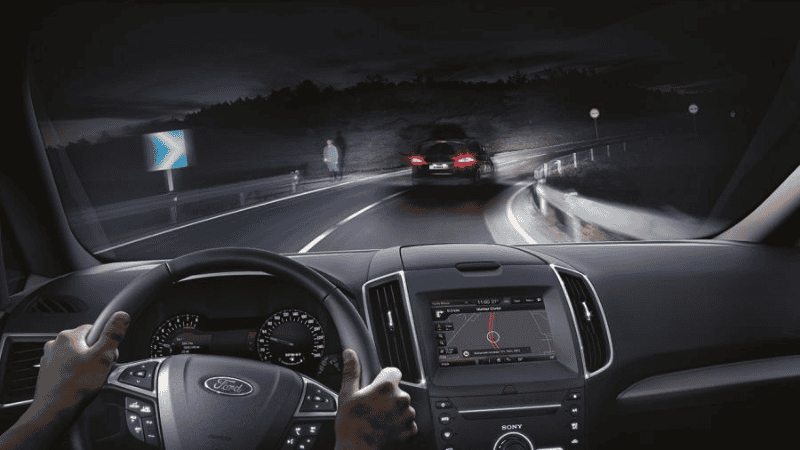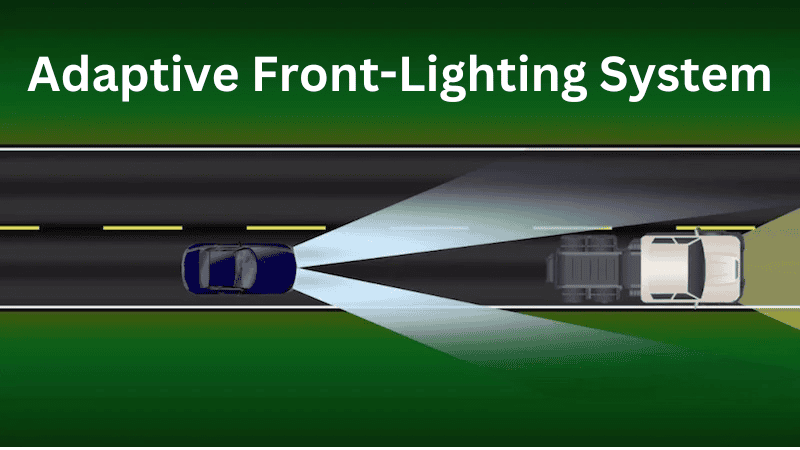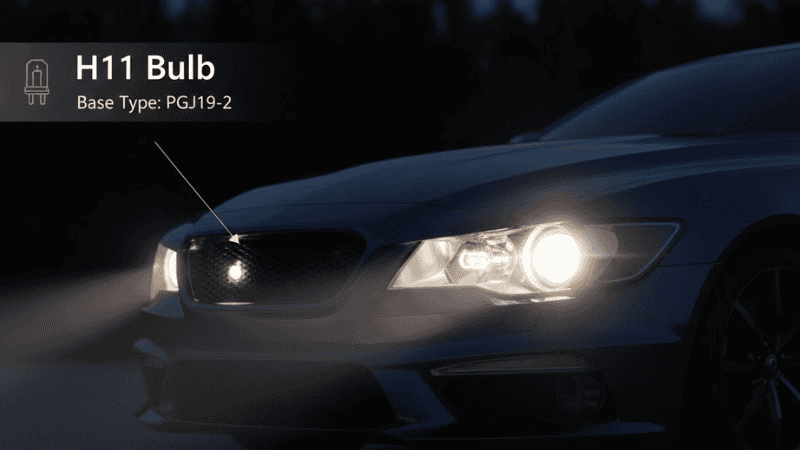According to State Farm, 90% of a driver’s reaction on the road is determined by vision. If a driver sees something late, they’re less likely to respond in time. This is why night driving, even with headlights, is so dangerous, but an adaptive front-lighting system can help.
Adaptive front-lighting systems enable drivers to spot hazards earlier around corners. This gives them a little more time to avoid accidents. In newer cars, systems that use LEDs have even more features.
In this article, we’ll examine adaptive front-lighting systems, how they work, and how they impact night-driving safety. We’ll also see how these systems compare to regular headlights and what to consider when choosing an AFS for your car.
What is An Adaptive Front-Lighting System (AFS)?

In its simplest form, an adaptive front-lighting system refers to headlights that turn with the steering wheel. This simple difference in the headlight system makes it easier for drivers to see around bends when driving at night and spot hazards earlier.
Dangers of Cornering
Cornering is one of the most common maneuvers you’ll make when driving, but it’s also quite dangerous even under normal conditions.

When driving around a corner, the car’s body is subjected to additional forces that can throw it off balance. The tires are also subjected to extra forces that increase the chances of losing traction. The results of cornering under extreme forces can be:
- Losing control of the car
- The car rolling
- The car leaves the road.
Poor visibility at night worsens the problem because spotting hazards is even harder. This increases the chances of breaking or swerving suddenly. Both of these put even more stress on the vehicle.
Spotting a hazard such as a stalled vehicle in your lane even a fraction of a second early can allow you to safely lower your speed or maneuver your car around.
History of Adaptive Front-Lighting Systems
The need for improved visibility when cornering was obvious even back in 1967. This was when an adaptive front-lighting system, called directional headlights, was first added to a mass-produced car; the Citroen DS.
In the Citroen DS, the headlights were connected to the steering using levers and cables. These could turn the headlights at nearly the same speed as the steering wheel.

Modern adaptive headlights are not physically linked to the steering gear. They are electronically controlled and more responsive.
The headlights in the 1967 Citroen DS used the standard automotive lighting systems of the time. Halogen bulbs or sealed beams, depending on location. Modern adaptive front-lighting systems use LED headlight bulbs.
LED headlight bulbs are brighter and more durable than halogen bulbs. However, they are also better suited to adaptive front-lighting systems.
LEDs are electronic devices and are more compatible with the electronic sensors and controls in modern cars. This has enabled the development of more advanced features of AFS systems.
How Adaptive Front-Lighting Systems Work
The main parts of a modern adaptive headlight system are the steering wheel sensors and articulating headlights. These allow the headlights to turn depending on the steering position. However, in many vehicle models, this is just the basic functionality of these systems.
1. Controlling Headlight Angle

To control the headlight angle, the steering wheel sensors keep track of the steering position when the headlights are on. When the steering wheel angle changes, stepper motors attached to the headlights are activated. These turn the headlight beam into the corner.
The magnitude of the headlight angle is proportional to the steering angle. However, there is a limit with many vehicles’ headlights only turning a maximum of 15° in either direction.
These systems are also attached to speed sensors, and different settings can be activated depending on vehicle speed.
2. Auto-leveling
This function maintains the axis of illumination to ensure the headlights are always pointed down. When the back of the car is heavily loaded or when the car is running over speed bumps, fixed headlights will be pointed higher up, potentially blinding oncoming drivers.
Auto-leveling changes the vertical angle of the headlights so the light beam doesn’t move up or down when the car’s position changes.
3. Automatic High Beams

This is a feature that can automatically switch between high beams and low beams. Headlights with this feature are also called auto-dip lights. This feature prevents your lights from blinding other drivers by automatically switching to low beams when a car is detected.
Sensors or cameras can be used to detect light from other cars. When a car is detected and the high beams are on, they are switched to low beams until the car passes.
4. LED Specific AFS Features
LED technology enables the addition of certain features to adaptive front-lighting systems that are not seen in halogen or HID headlights. These include:
- Glare-free high beams
- Wide-range low beams
- Highway mode
Glare-free high beams enable you to illuminate further down the road without the usual problem of blinding other drivers. This is possible because the headlights are made using multiple LEDs.
When oncoming traffic is detected, the system dims specific groups of LEDs while leaving the rest at peak brightness.

This changes the beam pattern to cover a shorter distance on the side of oncoming traffic while still covering the maximum range for high beams on the driving side.
The wide-range low beams are extra lights added to the sides of the headlights to improve illumination near the front sides of the car.
The highway mode is mostly seen in LED AFS systems. At very high speeds, the illumination axis is automatically raised so drivers can seem farther ahead. This enables them to spot hazards and traffic signs early.
Benefits of Adaptive Front-Lighting System
Adaptive front-lighting systems come with many benefits. Although they usually cost more, many owners are confident they are well worth the upgrade.
1. Improved Safety

This is the most important benefit of adaptive front-lighting systems. They make night driving safer for you, pedestrians, and other drivers. Changing the headlight angle during cornering means you’ll be able to spot pedestrians, stalled cars, or any other hazards.
Advanced features such as auto-leveling and automatic high beams reduce glare from your headlights so you don’t blind other drivers. The glare-free high beams in LED adaptive front-lighting systems achieve the same.
Wide-range low beams make it easier to spot and avoid pedestrians and animals at the sides of the road.
2. Convenience
Adaptive front-lighting systems in modern cars automatically perform many functions that drivers would otherwise have to do themselves. These include turning on the headlights when it gets dark and switching from high beams to low beams when a car is approaching.
Even the advanced functions, such as leveling the headlights, are done automatically without any input from the driver. This allows the driver to focus on steering and other core driving activities.
3. Beginner Friendly

Adaptive front-lighting systems make the challenging issue of controlling headlight functions easy. This is good for beginner drivers who are more likely to struggle with night driving. Knowing when to turn on headlights or when to switch from low to high beams may take some driving experience.
4. Comfort
With adaptive front-lighting systems, drivers can use brighter headlights with minimal risk of blinding others. They can enjoy greater visibility, making the driving experience more comfortable.
5. Future Potential
The future potential of LED AFS systems is one of the most exciting things about them. When paired with a traffic sign recognition system, you could get a speed limit sign indication displayed on the road in case you didn’t see the actual speed limit sign.
The same system could be used to show you the lanes on the road as part of the lane departure warning system or as a HUD for other important notifications you might otherwise miss. Such systems will be used with or instead of the excessive speed warning sound to keep drivers alert.
Comparative Analysis of AFS with LED Vs. Traditional Lighting Systems
Car owners can find adaptive front-lighting systems for LED, HID (xenon), and halogen lighting systems. However, the performance of these systems is very different.
AFS in LED Vs Traditional Lighting Systems
| AFS Features | LED | Halogen | HID |
|---|
As seen in the table above, adaptive front-lighting systems that use LEDs have certain features that are not available with other lighting systems. However, even with features available for HID and halogen headlights, the implementation tends to be better with LEDs.
Why AFS Works Better With LED
An adaptive front-lighting system paired with LED lights is becoming a common feature. This is not because LED headlights are the newest thing around. LED lighting has qualities that offer practical advantages over HID and halogen lighting in these systems.
- Faster Response Time
Many advanced features of adaptive front-lighting systems depend on the fast response time of LEDs. LEDs are electronic devices that can be turned on and off instantly. Features such as automatic high beams are more responsive in LED headlights than in xenon lights.
Features such as glare-free high beams also work because groups of LEDs can be quickly dimmed or turned off and on instantly.
- Finer Control

LED headlights consist of multiple light sources. In some cars, the headlight systems are made using over 19,000 microLEDs.
These multiple light sources can be controlled to a finer degree, enabling the accurate beam shaping needed for glare-free high beams and other features. This level of control is not possible with xenon or halogen light sources.
- Customization
Thanks to the finer control mentioned above, LED headlights can also be customized to achieve more interesting designs.
You may already have seen cars where several LED lights in the headlights are arranged in unique designs. In the future, this customization will be used to display alerts on the road for the driver.
- Less Heat Emission

LEDs produce significantly less heat than traditional lighting systems. Multiple LEDs can be placed next to each other at full brightness without the risk of excessive heat, which would damage the LEDs and the headlight assembly.
- Energy Efficiency
The superior energy efficiency of LEDs is another important feature that makes advanced front lighting systems better. Having multiple light sources running at the same time is only possible because each LED requires very little energy to power it.
Considerations When Choosing AFS With LED Headlights
If you’re in the market for an LED advanced front-lighting system, there are several considerations you’ll have to keep in mind, including:
- Cost: LED AFS systems can be quite pricey. In some cases, you can save money by not getting specific features. When buying these headlight systems, you’ll want to consider how much you’re willing to spend and which features are a must-have.

- Features: Certain LED advanced front lighting system features are only available for specific vehicles or from specific manufacturers.
- Quality: Replacing your AFS system later is something you want to avoid due to the costs involved. This is possible with LEDs because of their long lifespans. This is also why you should choose top-quality LED systems that are less likely to fail.
- Manufacturer: There are different manufacturers for both OEM/ODM and aftermarket AFS headlights. Consider the manufacturer’s reputation when buying to avoid making an expensive mistake.
Conclusion
Adaptive front-lighting systems are the future of vehicle headlights, and LED technology will make them even better. These lights make cornering and night driving safer for everyone on the road, including pedestrians.
There are AFS systems that work with traditional headlights, but LEDs perform better and have led to the introduction of new features that improve safety and convenience. When choosing these lighting systems, pay attention to the quality of LEDs used and the manufacturer.
Discover LED Adaptive Front-Lighting Systems From Carlightvision
Carlightvision is a reputable manufacturer of automotive LED headlight systems. Our team of experts designs and produces LED lighting solutions for OEM/ODM customers and aftermarket distributors.
Our product quality is one of many qualities that set us apart from the competition. Contact us to find out more about LED adaptive headlights and the solutions we offer.




